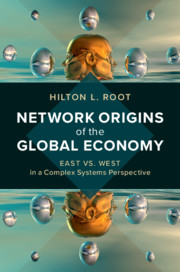Book contents
- Network Origins of the Global Economy
- Network Origins of the Global Economy
- Copyright page
- Dedication
- Contents
- Figures
- Tables
- Contributors
- Preface
- Overview
- Acknowledgments
- Part I Political Economy and Complex Systems
- 1 Great Transitions in Economic History
- 2 Growth, Form, and Self-Organization in the Economy
- 3 Human Evolutionary Behavior and Political Economy
- Part II An Analysis of Historical Regimes
- Part III The Coming Instability
- References
- Index
1 - Great Transitions in Economic History
from Part I - Political Economy and Complex Systems
Published online by Cambridge University Press: 17 March 2020
- Network Origins of the Global Economy
- Network Origins of the Global Economy
- Copyright page
- Dedication
- Contents
- Figures
- Tables
- Contributors
- Preface
- Overview
- Acknowledgments
- Part I Political Economy and Complex Systems
- 1 Great Transitions in Economic History
- 2 Growth, Form, and Self-Organization in the Economy
- 3 Human Evolutionary Behavior and Political Economy
- Part II An Analysis of Historical Regimes
- Part III The Coming Instability
- References
- Index
Summary
The upheavals of recent decades have shocked social scientists who continue to base their development models on the West’s economic trajectory and the idea that as modernization and economic cooperation take hold the world’s nations, in some broad linear convergence, will operate with free markets, limited government, and greater pluralism and tolerance. But it is clear that authoritarian states can host properous, efficient economies as readily as full-fledged democracies, and that the global system is not edging toward some equilibrium state or neoliberal “end of history.” Nor are the world’s societies all part of an overarching order that can be fine-tuned with equilibrium models. They are parts of open, adaptive, complex systems – and we must consider the dynamics to which such systems are prone. We look at how network dynamics determine system stability: how, for example, China has attained global leadership, and why the West struggles to maintain influence. Models of the network topography of premodern Europe and China illustrate how linkages, once formed, create actors, shape behaviors, and mold relationships that hold sway over the trajectories of the societies in which they arise.
Keywords
- Type
- Chapter
- Information
- Network Origins of the Global EconomyEast vs. West in a Complex Systems Perspective, pp. 3 - 14Publisher: Cambridge University PressPrint publication year: 2020



